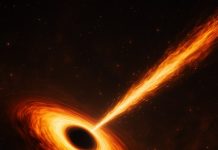
NASA and JAXA, the Japanese Aerospace Exploration Agency, have made exciting new discoveries with their joint X-ray mission, XRISM, which is investigating the cosmos in ways never before possible.
XRISM, which launched in September 2023, has recently examined the supermassive black hole at the center of galaxy NGC 4151, located about 43 million light-years away in the constellation Canes Venatici.
Brian Williams, NASA’s project scientist for the mission, explains that XRISM’s Resolve instrument has captured a detailed X-ray spectrum of the area around the black hole.
This spectrum shows specific peaks and dips that act like fingerprints, indicating the presence of various elements, including iron.
Such detailed data helps scientists understand the complex interactions occurring as matter is drawn into the black hole.
NGC 4151 is known as an active galaxy because its center is exceptionally bright and variable, which is typical when a supermassive black hole is actively consuming material from its surroundings.
This galaxy features an accretion disk, a swirling mass of gas and dust that orbits and feeds the black hole. The gravitational and frictional forces within the disk heat the material, causing it to emit high levels of energy, particularly X-rays.
The center of NGC 4151 also features a torus, a donut-shaped cloud of cooler material that surrounds the hotter accretion disk.
XRISM’s observations have revealed fascinating details about how this structure interacts with the X-rays emitted by the accretion disk.
The Resolve instrument detected a sharp peak in the X-ray spectrum at about 6.5 keV (kiloelectron volts), which corresponds to the emission of iron.
This occurs when X-rays from the hot regions near the black hole strike the cooler gas in the disk, causing the iron within the gas to fluoresce, or light up, providing a bright signature that astronomers can study.
Additionally, the spectrum showed several dips around 7 keV, indicating areas where X-rays were absorbed by the iron in the torus.
This absorption occurs because the torus is much cooler compared to the disk and thus interacts differently with the X-rays.
These findings are significant because they help astronomers piece together a clearer image of the environment around black holes in active galaxies like NGC 4151. Understanding these interactions is crucial for unraveling how supermassive black holes evolve and influence their host galaxies over cosmic time.
The XRISM mission, which involves collaboration from JAXA, NASA, ESA, and CSA, promises to continue expanding our knowledge of the universe with its unique ability to detect and analyze various elements through their X-ray signatures.
This mission not only deepens our understanding of black holes but also enhances our overall grasp of the cosmos’s vast and varied phenomena.
Source: NASA.



